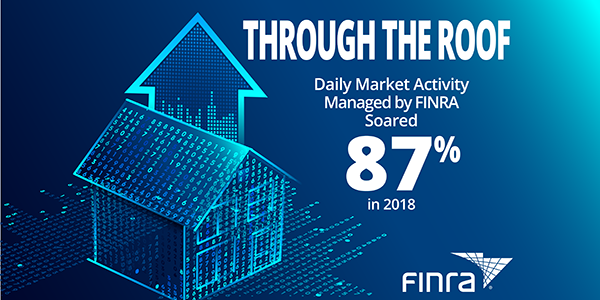
- Daily Market Activity Soars 87 Percent to New Record
- 28 of the 30 Most-Active Dates in History Occur in 4Q 2018
- New High of 135 Billion Records/Day Almost Quadruples 2017’s Daily Average
- Before 2018, All-Time High Was 75 Billion Records in Single Day; That’s 34 Billion Fewer Than an Average Day in December 2018
Exceptional market volatility generated an unprecedented amount of processing volume for FINRA in 2018 – 66.7 billion electronic records per day, an 87.4 percent increase over the average daily volume in 2017. FINRA’s pioneering cloud strategy allowed it to handle the record-setting volume smoothly while continuing to perform vigorous regulatory oversight of securities trading.
“The story of 2018 was not just the individual, breakthrough days that set new records – it was also the sustained, high-volume activity that we managed for days and even weeks at a time,” said CIO and Executive Vice President Steve Randich. “Our mission of protecting investors depends on our staying current with the market and continuously monitoring and analyzing for potential suspicious activity. Cloud storage and processing responds instantly to elastic demand, providing our market-surveillance analysts with access to petabytes of data in seconds or minutes, even during periods of uninterrupted record-breaking activity.”
Trading activity in the stock, options and fixed-income markets creates a variety of electronic records that FINRA monitors for regulatory purposes. Every day, FINRA receives order and trade data regarding 42,000 investment products from 17 securities exchanges, more than 60 alternative trading systems and almost 1,400 broker-dealer firms. FINRA runs almost 200 algorithmic “patterns” to look for more than 300 potential threat scenarios including market manipulation, fraud, customer abuse, insider trading, abusive short selling, inaccurate trade reporting, and other rule violations.

| Year | Average Daily Records Processed (Billions) |
| 2018 | 66.7 |
| 2017 | 35.6 |
| 2016 | 37.4 |
| 2015 | 42.3 |
2018 – A Record Year, Month by Month
| Month | Average Daily Records Processed (Billions) |
| January | 42.5 |
| February | 67.8 |
| March | 63.5 |
| April | 67.9 |
| May | 54.3 |
| June | 52.9 |
| July | 52.6 |
| August | 51.9 |
| September | 57.6 |
| October | 93.4 |
| November | 89.7 |
| December | 108.8 |
All of the 30 Most-Active Dates in History Occurred in 2018 – 28 of them in 4Q
| Date | Records Processed (Billions) | Date | Records Processed (Billions) |
| 12-20 | 135.1 | 11-14 | 111.4 |
| 10-11 | 134.7 | 12-11 | 110.7 |
| 10-30 | 132.9 | 11-02 | 110.6 |
| 10-26 | 130.0 | 10-24 | 109.5 |
| 12-27 | 129.8 | 10-12 | 107.9 |
| 12-10 | 127.5 | 10-10 | 107.4 |
| 11-20 | 126.8 | 12-04 | 107.0 |
| 12-06 | 125.0 | 11-13 | 106.3 |
| 12-21 | 124.3 | 12-17 | 106.0 |
| 12-07 | 123.7 | 10-23 | 104.6 |
| 12-28 | 122.8 | 11-19 | 104.2 |
| 10-29 | 117.4 | 12-18 | 102.7 |
| 12-26 | 115.6 | 03-28 | 101.1 |
| 12-19 | 114.8 | 02-09 | 99.1 |
| 11-15 | 113.0 | 12-13 | 98.7 |
Fact Sheet
- Dynamic scalability was one of the key factors FINRA considered when it made the decision in 2014 to move 90 percent of its processing and storage work to the cloud by the end of 2016. Randich explained these and other benefits in a podcast and blog post last year.
- Adoption of the cloud strategy has made it possible for FINRA to not only stay ahead of growing volume but also perform increasingly sophisticated surveillance across U.S. securities markets. Thomas Gira, Executive VP, Market Regulation and Transparency Services, discussed these advances in a podcast last year.
- Before implementing its cloud strategy, FINRA operated with a traditional data-center approach, in which capacity is limited to that of the servers in a data center. Had FINRA stayed with that approach, the volume from any one of the exceptional days of 2018 could have taken days to finish processing, an effect that would compound with heavy activity in succeeding days. As a self-regulatory organization, FINRA was able to make multi-year investments that supported this innovative regtech approach.
- In addition developing its own advances in regtech, FINRA recently released a white paper outlining recent regtech developments in the securities industry and potential opportunities and implications these technologies may have for broker-dealers.












